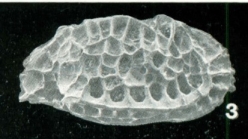
| Intro | | Search taxa | | Bibliography | | Distributions | | Photogallery | | Statistics | | Taxon tree | | Log in |
Ostracoda taxon detailsBradleya caudata Whatley, Downing, Kesler & Harlow, 1984
776363 (urn:lsid:marinespecies.org:taxname:776363)
accepted
Species
marine,
Whatley, R.C., Downing, S.E., Kesler, K. and Harlow, C.J. (1984a) New species of the ostracod genus Bradleya from the Tertiary and Quaternary of D.S.P.D.P. sites in the southwest Pacific. Revista Espanola de Micropaleontologia 16, 265–298. [details]
Type locality contained in Queensland
type locality contained in Queensland [details]
Description "Large, robust. Elongate, sub-rectangular to sub-ovate. Anterior broadly rounded, asymmetrically so in LV extremity below...
Description "Large, robust. Elongate, sub-rectangular to sub-ovate. Anterior broadly rounded, asymmetrically so in LV extremity below mid-height. Posterior caudate, more so in RV. Both margins denticulate. Dorsal margin straight to gently convex. Reticulum well-developed. Muri somewhat irregularly distributed over valve surface; bold, sharp and of high relief with the exception of the posterior fifth where they "becomes low and subdued. Ventro-Iateral and dorsal ridge prominent, non-spinose. Bridge modified; muri raised and thickened, forming a prominent, circular mural structure enclosing the frontal muscle scar area. A weak and irregular median ridge extends posteriorly from this structure, disrupting the median loop and causing the adductor muscle scars to be enclosed within a similar, but larger, circular mural framework. Foveolate. Normal pore canals and inner lamella details as for genus; radial pore canals tending to be grouped in pairs. Hinge holamphidont, posterior terminal tooth of RV slightly arcuate and nonlobate." (Whatley, Downing, Kesler & Harlow, 1984: 281) [details] Etymology “Derivatio nominis. L. Referring to the unusually produced posterior margin of this species" (Whatley, Downing, Kesler &...
Etymology “Derivatio nominis. L. Referring to the unusually produced posterior margin of this species" (Whatley, Downing, Kesler & Harlow, 1984: 281) [details] Stratigraphy "Section 4, Level 90-95 cms. Miocene, Zone N. 14." (Whatley, Downing, Kesler & Harlow, 1984: 281)
Stratigraphy "Section 4, Level 90-95 cms. Miocene, Zone N. 14." (Whatley, Downing, Kesler & Harlow, 1984: 281) [details]
Brandão, S. N.; Antonietto, L. S.; Pereira, J. S.; Pereira, S. G. G.; Sá, H. A. B.; Praxedes, R. A.; Sabater, L. M., Santos, S.G.; Karanovic, I. (2025). World Ostracoda Database. Bradleya caudata Whatley, Downing, Kesler & Harlow, 1984. Accessed at: https://www.marinespecies.org/ostracoda/aphia.php?p=taxdetails&id=776363 on 2025-05-06
Date action by
original description
Whatley, R.C., Downing, S.E., Kesler, K. and Harlow, C.J. (1984a) New species of the ostracod genus Bradleya from the Tertiary and Quaternary of D.S.P.D.P. sites in the southwest Pacific. Revista Espanola de Micropaleontologia 16, 265–298. [details]
 Present Present  Inaccurate Inaccurate  Introduced: alien Introduced: alien  Containing type locality Containing type locality
Unknown type BMNH OS 7085, geounit Queensland [details]
From editor or global species database
Description "Large, robust. Elongate, sub-rectangular to sub-ovate. Anterior broadly rounded, asymmetrically so in LV extremity below mid-height. Posterior caudate, more so in RV. Both margins denticulate. Dorsal margin straight to gently convex. Reticulum well-developed. Muri somewhat irregularly distributed over valve surface; bold, sharp and of high relief with the exception of the posterior fifth where they "becomes low and subdued. Ventro-Iateral and dorsal ridge prominent, non-spinose. Bridge modified; muri raised and thickened, forming a prominent, circular mural structure enclosing the frontal muscle scar area. A weak and irregular median ridge extends posteriorly from this structure, disrupting the median loop and causing the adductor muscle scars to be enclosed within a similar, but larger, circular mural framework. Foveolate. Normal pore canals and inner lamella details as for genus; radial pore canals tending to be grouped in pairs. Hinge holamphidont, posterior terminal tooth of RV slightly arcuate and nonlobate." (Whatley, Downing, Kesler & Harlow, 1984: 281) [details]Diagnosis “An elongate and caudate species of Bradleya with a bold reticulum; muri sharp and of high relief. Bridge modified into a prominent, circular mural structure completely enclosing the frontal muscle scar area. Weak median ridge disrupting the vertical median loop. Ridges lacking spines." (Whatley, Downing, Kesler & Harlow, 1984: 281) [details] Etymology “Derivatio nominis. L. Referring to the unusually produced posterior margin of this species" (Whatley, Downing, Kesler & Harlow, 1984: 281) [details] Stratigraphy "Section 4, Level 90-95 cms. Miocene, Zone N. 14." (Whatley, Downing, Kesler & Harlow, 1984: 281) [details] |

